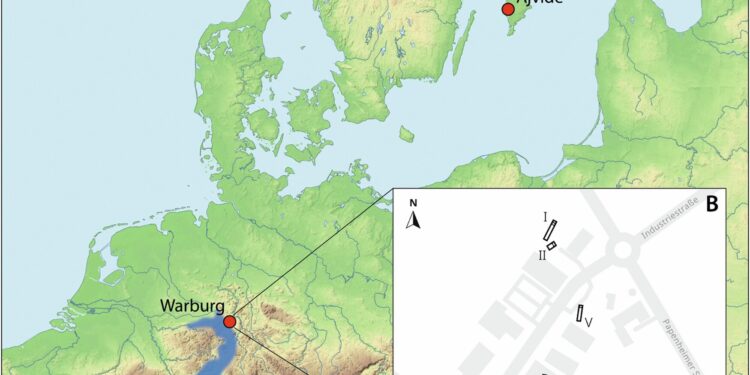Map of Late Neolithic sites. Credit: Biology of communications (2024). DOI: 10.1038/s42003-024-06676-7
Since the catastrophic pandemics of the Middle Ages, one disease has almost proverbially symbolised contagion and death: the plague. It is now known that the bacterium responsible for the plague, Yersinia pestis, has been present in Central and Northern Europe for over 5,000 years. However, it is still unclear whether it also caused pandemics and mass deaths in its early forms.
Researchers from Kiel, Münster, Schleswig and Hamburg have now analysed bones of late Neolithic farmers as part of the Collaborative Research Centre 1266 “Scales of Transformation” at Kiel University (CAU).
“Our analyses indicate isolated infections rather than outbreaks,” said Professor Ben Krause-Kyora, an ancient DNA (aDNA) specialist at the Institute of Clinical Molecular Biology at Kiel University and lead author of the study published in Biology of communications.
For this study, the team genetically analyzed the bones of 133 human individuals from Late Neolithic megalithic graves near Warburg in North Rhine-Westphalia. These graves belong to the so-called Wartberg culture, which dates back to around 5,500 to 4,800 years BCE.
The team identified the genome of the plague-causing bacterium, Yersinia pestis, in bone samples from two individuals. The bacteria belonged to different strains. The infected individuals were unrelated, lived at different times, and were buried in separate megalithic tombs. This suggests that the infections were independent incidents, with no direct transmission between the two people.
“Overall, we see a high diversity of Yersinia pestis during the Neolithic period. This could indicate a low specialization of the bacterium at this early stage of its evolution. This may have facilitated its survival in different environments and in different animals,” explains Ben Krause-Kyora.
These results and the low number of plague cases among the 133 individuals examined show that the megalithic structures do not represent collective burials of victims of a massive plague epidemic. It is still unknown whether the early forms of Yersinia pestis caused symptoms as severe as those of the Middle Ages.
But how did Neolithic people become infected? Unlike medieval strains of the bacteria, Neolithic strains could not be transmitted by fleas.
During the Neolithic period, deforestation changed the landscapes of central and northern Europe. New rodent species appeared from the eastern and southern steppes. These regions may have been natural reservoirs of Yersinia pestis.
“However, we don’t know how often humans had contact with these animals or their carcasses,” Krause-Kyora says. Previously published genomic data from a bone sample of a Neolithic dog from Sweden indicated a possible route of infection. When the Kiel team reanalyzed the data, they found that the dog had also been infected with the plague bacteria at the time of its death.
“This is the first time that the presence of Yersinia pestis has been reported in a Neolithic dog. Since dogs were often present in human settlements at that time, they could have played a role in some infections,” explains Krause-Kyora.
“Overall, the results of our study suggest that the plague pathogen was already frequently present in or near human settlements, but led to isolated infections rather than large-scale epidemics,” Krause-Kyora sums up.
“These results are also crucial for the ROOTS cluster of excellence, where we are studying how changes in climate, land use and diet may have influenced the spread of pathogens, particularly Yersinia pestis.”
More information:
Julian Susat et al, Neolithic Yersinia pestis infections in humans and a dog, Biology of communications (2024). DOI: 10.1038/s42003-024-06676-7
Provided by Kiel University
Quote: Neolithic bones reveal isolated Yersinia pestis infections, not pandemics (2024, September 6) retrieved September 7, 2024 from
This document is subject to copyright. Apart from any fair dealing for the purpose of private study or research, no part may be reproduced without written permission. The content is provided for informational purposes only.



